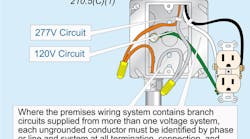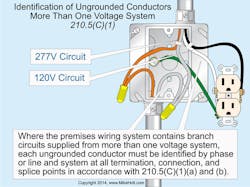Stumped by the Code? Rules for the identification of branch circuit conductors
Q. What are the Code rules for the identification of branch circuit conductors?
A. The neutral conductor of a branch circuit must be identified in accordance with Sec. 200.6 [210.5(A)].
Equipment grounding conductors can be bare, covered, or insulated. Insulated equipment grounding conductors size 6 AWG and smaller must have a continuous outer finish either green or green with one or more yellow stripes [250.119]. On equipment grounding conductors 4 AWG and larger, insulation can be permanently re-identified with green marking at the time of installation at every point where the conductor is accessible [250.119(A)].
If the premises wiring system contains branch circuits supplied from more than one voltage system, each ungrounded conductor must be identified by phase and system at all termination, connection, and splice points in accordance with 210.5(C)(1)(a) and (b) (see Figure). Identification can be by color-coding, marking tape, tagging, or other means approved by the authority having jurisdiction. The method of identification must be documented in a manner that’s readily available or permanently posted at each branch-circuit panelboard.
When a premises has more than one voltage system supplying branch circuits, the ungrounded conductors must be identified by phase and system. This can be done by permanently posting an identification legend that describes the method used, such as color-coded marking tape or color-coded insulation. Conductors with insulation that’s green or green with one or more yellow stripes can’t be used for an ungrounded or neutral conductor [250.119].
Although the NEC doesn’t require a specific color code for ungrounded conductors, electricians often use the following color system for power and lighting conductor identification:
120/240V, single-phase — black, red, and white
120/208V, 3-phase — black, red, blue, and white
120/240V, 3-phase — black, orange, blue, and white
277/480V, 3-phase — brown, orange, yellow, and gray; or, brown, purple, yellow, and gray
Q. What are the Code requirements for the location of overcurrent devices?
A. Circuit breakers and fuses must be readily accessible, and they must be installed so the center of the grip of the operating handle of the fuse switch or circuit breaker, when in its highest position, isn’t more than 6 ft, 7 in. above the floor or working platform, unless the installation is for [240.24(A)]:
(1) Busways, as provided in Sec. 368.17(C).
(2) Supplementary overcurrent devices aren’t required to be readily accessible [240.10].
(3) For overcurrent devices, as described in Sec. 225.40 and Sec. 230.92.
(4) Overcurrent devices located next to equipment can be mounted above 6 ft, 7 in., if accessible by portable means [404.8(A), Exception No. 2].
As noted in Sec. 240.24(C), overcurrent devices must not be exposed to physical damage. An Informational Note also says that electrical equipment must be suitable for the environment, and consideration must be given to the presence of corrosive gases, fumes, vapors, liquids, or chemicals that have a deteriorating effect on conductors or equipment [110.11].
Overcurrent devices must not be located near easily ignitable material, such as in clothes closets, and they aren’t permitted to be located in the bathrooms of dwelling units, dormitories, or guest rooms or guest suites of hotels or motels. Note: The service disconnecting means must not be located in a bathroom, even in commercial or industrial facilities [230.70(A)(2)].
Overcurrent devices must not be located over the steps of a stairway. Note: It’s difficult for electricians to safely work on electrical equipment located on uneven surfaces like stairways.
These materials are provided to us by Mike Holt Enterprises in Leesburg, Fla. To view Code training materials offered by this company, visit www.mikeholt.com/code






